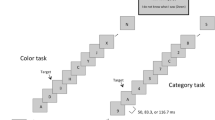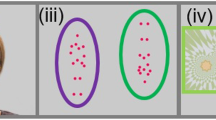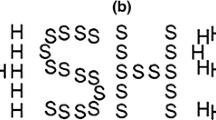Abstract
Visual attention of adolescents with autism spectrum disorder (ASD) was assessed using a change blindness paradigm. Twenty-five adolescents with ASD aged 12–18 years and 25 matched typically developing (TD) adolescents viewed 36 pairs of digitized real-world images. Each pair of images was displayed in a ‘flicker paradigm’ whereby a particular item alternately appeared and disappeared. This item was either a central or a marginal detail of the scene. Change detection response times were measured and compared between groups. Marginal details were more difficult to detect than central details of the scenes in both groups, however, the response times of the ASD group were lower than the TD group. These results challenge the hypothesis of superior visual detection in ASD.



Similar content being viewed by others

References
American Psychiatric Association. (2013). Diagnostic and statistical manual of mental disorders: DSM 5. Washington: American Psychiatric Association.
Benson, V., Castelhano, M. S., Howard, P. L., Latif, N., & Rayner, K. (2016). Looking, seeing and believing in autism: Eye movements reveal how subtle cognitive processing differences impact in the social domain. Autism Research, 9(8), 879–887.
Burack, J. A., Joseph, S., Russo, N., Shore, D. I., Porporino, M., & Enns, J. T. (2009). Change detection in naturalistic pictures among children with autism. Journal of Autism and Developmental Disorders, 39(3), 471–479.
Dunn, L., & Dunn, D. (2007). Peabody picture vocabulary test. bloomington, MN: NCS pearson.
Enns, J. T., & Trick, L. M. (2006). Four modes of selection. In Lifespan cognition: Mechanisms of change (pp. 43–56). Oxford: Oxford University Press.
Ferrer, E., Whitaker, K. J., Steele, J. S., Green, C. T., Wendelken, C., & Bunge, S. A. (2013). White matter maturation supports the development of reasoning ability through its influence on processing speed. Developmental Science, 16(6), 941–951.
Fletcher-Watson, S., Findlay, J. M., Leekam, S. R., & Benson, V. (2008). Rapid detection of person information in a naturalistic scene. Perception, 37(4), 571–583.
Fletcher-Watson, S., Leekam, S., Turner, M., & Moxon, L. (2006). Do people with autistic spectrum disorder show normal selection for attention? Evidence from change blindness. British Journal of Psychology, 97(4), 537–554.
Fletcher-Watson, S., Leekam, S. R., Connolly, B., Collis, J. M., Findlay, J. M., McConachie, H., & Rodgers, J. (2012). Attenuation of change blindness in children with autism spectrum disorders. British Journal of Developmental Psychology, 30(3), 446–458.
Frith, U., & Happé, F. (1994). Autism: Beyond “theory of mind”. Cognition, 50(1–3), 115–132.
Happé, F., & Frith, U. (2006). The weak coherence account: Detail-focused cognitive style in autism spectrum disorders. Journal of Autism and Developmental Disorders, 36(1), 5–25.
Iarocci, G., Burack, J. A., Shore, D. I., Mottron, L., & Enns, J. T. (2006). Global–local visual processing in high functioning children with autism: Structural vs. implicit task biases. Journal of Autism and Developmental Disorders, 36(1), 117–129.
Jolliffe, T., & Baron-Cohen, S. (1997). Are people with autism and asperger syndrome faster than normal on the embedded figures test? Journal of Child Psychology and Psychiatry, 38(5), 527–534.
Kail, R. (1991). Developmental change in speed of processing during childhood and adolescence. Psychological Bulletin, 109(3), 490–501. doi:10.1037/0033-2909.109.3.490.
Kail, R. V., & Ferrer, E. (2007). Processing speed in childhood and adolescence: Longitudinal models for examining developmental change. Child Development, 78(6), 1760–1770.
Kaldy, Z., Giserman, I., Carter, A. S., & Blaser, E. (2016). The mechanisms underlying the ASD advantage in visual search. Journal of Autism and Developmental Disorders, 46(5), 1513–1527.
Keehn, B., Müller, R., & Townsend, J. (2013). Atypical attentional networks and the emergence of autism. Neuroscience & Biobehavioral Reviews, 37(2), 164–183.
Kevin O’Regan, J., Deubel, H., Clark, J. J., & Rensink, R. A. (2000). Picture changes during blinks: Looking without seeing and seeing without looking. Visual Cognition, 7(1–3), 191–211.
Lavie, N. (2005). Distracted and confused? Selective attention under load. Trends in Cognitive Sciences, 9(2), 75–82.
Lavie, N. (2010). Attention, distraction, and cognitive control under load. Current Directions in Psychological Science, 19(3), 143–148.
Lavie, N., Hirst, A., de Fockert, J. W., Viding, E. (2004). Load theory of selective attention and cognitive control. Journal of Experimental Psychology: General, 133(3), 339–354.
Lord, C., Rutter, M., DiLavore, P., Risi, S., Gotham, K., & Bishop, S. (2012). Autism diagnostic observation schedule, (ADOS-2) modules 1–4. Los Angeles: Western Psychological Services.
Loth, E., Carlos Gómez, J., & Happé, F. (2008). Detecting changes in naturalistic scenes: Contextual inconsistency does not influence spontaneous attention in high-functioning people with autism spectrum disorder. Autism Research, 1(3), 179–188.
Mayes, S. D., & Calhoun, S. L. (2007). Learning, attention, writing, and processing speed in typical children and children with ADHD, autism, anxiety, depression, and oppositional-defiant disorder. Child Neuropsychology, 13(6), 469–493.
Mottron, L., Burack, J. A., Iarocci, G., Belleville, S., & Enns, J. T. (2003). Locally oriented perception with intact global processing among adolescents with high-functioning autism: Evidence from multiple paradigms. Journal of Child Psychology and Psychiatry, 44(6), 904–913.
Mottron, L., Dawson, M., Soulieres, I., Hubert, B., & Burack, J. (2006). Enhanced perceptual functioning in autism: An update, and eight principles of autistic perception. Journal of Autism and Developmental Disorders, 36(1), 27–43.
New, J. J., Schultz, R. T., Wolf, J., Niehaus, J. L., Klin, A., German, T. C., & Scholl, B. J. (2010). The scope of social attention deficits in autism: Prioritized orienting to people and animals in static natural scenes. Neuropsychologia, 48(1), 51–59.
O’Riordan, M. A., Plaisted, K. C., Driver, J., & Baron-Cohen, S. (2001). Superior visual search in autism. Journal of Experimental Psychology: Human Perception and Performance, 27(3), 719–730. doi:10.1037//0096-1523.27.3.719.
Oliveras-Rentas, R. E., Kenworthy, L., Roberson, R. B., Martin, A., & Wallace, G. L. (2012). WISC-IV profile in high-functioning autism spectrum disorders: Impaired processing speed is associated with increased autism communication symptoms and decreased adaptive communication abilities. Journal of Autism and Developmental Disorders, 42(5), 655–664.
Pashler, H., Johnston, J. C., & Ruthruff, E. (2001). Attention and performance. Annual Review of Psychology, 52(1), 629–651.
Pashler, H. E. (1998). Psychology of attention. Cambridge: MIT Press.
Raven, J. C. (1998). Raven’s progressive matrices. Oxford: Oxford Psychologists Press.
Remington, A., Swettenham, J., Campbell, R., & Coleman, M. (2009). Selective attention and perceptual load in autism spectrum disorder. Psychological Science, 20(11), 1388–1393. doi:10.1111/j.1467-9280.2009.02454.x.
Rensink, R. A. (2002). Change detection. Annual Review of Psychology, 53(1), 245–277.
Rensink, R. A., O’Regan, J. K., & Clark, J. J. (1997). To see or not to see: The need for attention to perceive changes in scenes. Psychological Science, 8(5), 368–373.
Riby, D. M., Brown, P. H., Jones, N., & Hanley, M. (2012). Brief report: Faces cause less distraction in autism. Journal of Autism and Developmental Disorders, 42(4), 634–639.
Rutter, M., Bailey, A., Lord, C., & Berument, S. (2003). Social communication questionnaire. Los Angeles: Western Psychological Services.
Sakia, R. (1992). The box-cox transformation technique: A review. The Statistician, 169–178.
Shah, A., & Frith, U. (1993). Why do autistic individuals show superior performance on the block design task? Journal of Child Psychology and Psychiatry, 34(8), 1351–1364.
Sheth, B. R., Liu, J., Olagbaju, O., Varghese, L., Mansour, R., Reddoch, S., … Loveland, K. A. (2011). Detecting social and non-social changes in natural scenes: Performance of children with and without autism spectrum disorders and typical adults. Journal of Autism and Developmental Disorders, 41(4), 434–446.
Shore, D. I., Burack, J. A., Miller, D., Joseph, S., & Enns, J. T. (2006). The development of change detection. Developmental Science, 9(5), 490–497.
Shore, D. I., & Klein, R. M. (2000). The effects of scene inversion on change blindness. The Journal of General Psychology, 127(1), 27–43.
Simons, D. J., & Rensink, R. A. (2005). Change blindness: Past, present, and future. Trends in Cognitive Sciences, 9(1), 16–20.
Smith, H., & Milne, E. (2009). Reduced change blindness suggests enhanced attention to detail in individuals with autism. Journal of Child Psychology and Psychiatry, 50(3), 300–306.
Van Dillen, L. F., Heslenfeld, D. J., & Koole, S. L. (2009). Tuning down the emotional brain: An fMRI study of the effects of cognitive load on the processing of affective images. NeuroImage, 45(4), 1212–1219.
Wallace, G. L., Anderson, M., & Happé, F. (2009). Brief report: Information processing speed is intact in autism but not correlated with measured intelligence. Journal of Autism and Developmental Disorders, 39(5), 809–814.
Wallace, G. L., Kenworthy, L., Pugliese, C. E., Popal, H. S., White, E. I., Brodsky, E., & Martin, A. (2016). Real-world executive functions in adults with autism spectrum disorder: Profiles of impairment and associations with adaptive functioning and co-morbid anxiety and depression. Journal of Autism and Developmental Disorders, 46(3), 1071–1083.
Acknowledgments
This work was supported in part by the PICS program (Ref: PICS07209) of the CNRS (National Center for Scientific Research, France) and by the Caesarea Edmond Benjamin De Rothschild Institute (Haifa, Israel). This work was also supported by Erasmus Mundus EMAIL II Program of the European Union.
Author Contributions
MH conceptualized and designed the study, recruited participants, carried out the initial analyses, drafted the initial manuscript, reviewed and revised the manuscript. OG conceptualized and designed the study, carried out the initial analyses, drafted the initial manuscript and reviewed and revised the manuscript. AA recruited participants, collected data and reviewed and revised the manuscript. All authors approved the final manuscript as submitted and agree to be accountable for all aspects of the work.
Author information
Authors and Affiliations
Corresponding author
Ethics declarations
Conflict of interest
The authors declare that they have no conflict of interest.
Ethical Approval
All procedures performed in studies involving human participants were in accordance with the ethical standards of the institutional and/or national research committee and with the 1964 Helsinki declaration and its later amendments or comparable ethical standards.
Informed Consent
Informed consent was obtained from all individual participants included in the study.
Rights and permissions
About this article
Cite this article
Hochhauser, M., Aran, A. & Grynszpan, O. How Adolescents with Autism Spectrum Disorder (ASD) Spontaneously Attend to Real-World Scenes: Use of a Change Blindness Paradigm. J Autism Dev Disord 48, 502–510 (2018). https://doi.org/10.1007/s10803-017-3343-6
Published:
Issue Date:
DOI: https://doi.org/10.1007/s10803-017-3343-6



